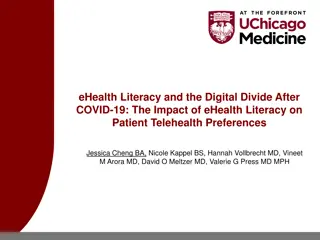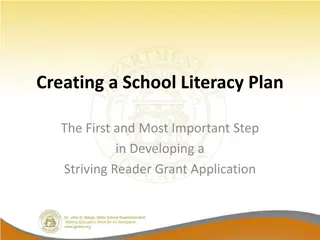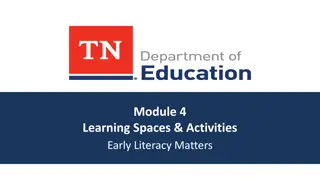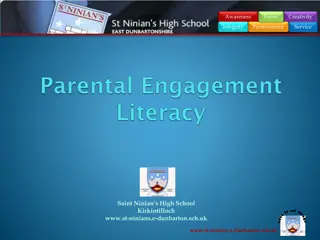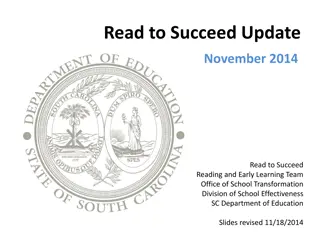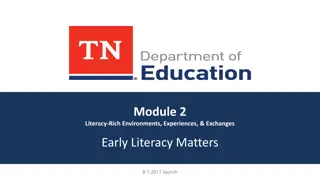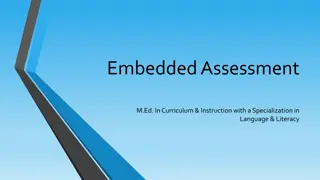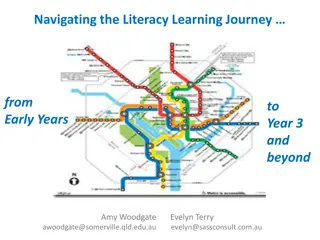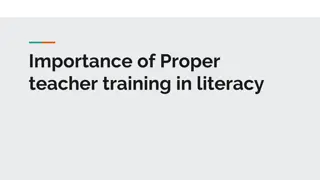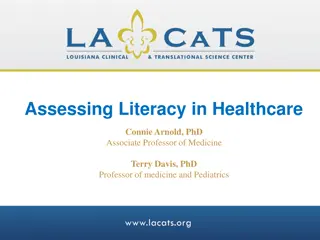Enhancing Literacy: Strategies for Effective Communication
Explore strategies for improving communication with low-literacy and ESL readers, delving into plain language editing, Canadian literacy statistics, factors influencing literacy, writing techniques, and readability best practices. Learn about the importance of plain language, effective writing techniques, and formatting and style considerations to enhance readability and engagement for diverse audiences.
Download Presentation

Please find below an Image/Link to download the presentation.
The content on the website is provided AS IS for your information and personal use only. It may not be sold, licensed, or shared on other websites without obtaining consent from the author. Download presentation by click this link. If you encounter any issues during the download, it is possible that the publisher has removed the file from their server.
E N D
Presentation Transcript
Beyond the plain language edit: Editing for low- literacy and ESL readers 9 10:30 a.m., March 28, 2015 Tracy Torchetti and Claire Foley ACES, Getting it right in Pittsburgh
Agenda Introduction Plain language Readability English as a second language Conclusion
Canadian literacy statistics 42% of adult Canadians have low literacy skills. More than 15 million Canadian adults will have low literacy skills by 2031, up 25% from 2001.
Canadian diversity 17% of the Canadian population are immigrants. 32% of Canadians don t have English as a first language.
Factors affecting literacy reading on small laptops, tablets, cell phones multi-tasking visual ability age stress cognitive ability
What is plain language? the art and science of writing clearly clear organization and layout reader-centred writing and design
Writing techniques Use the active voice. Write directly to your reader. Use a positive tone wherever possible. Use short words and simple sentences. Use common words instead of jargon. Use lists.
Formatting and style Watch alignment. Use lots of white space and short paragraphs. Keep lines of text short. Use meaningful titles, headings and subheadings. Use minimal emphasis (bold, all caps, italics, colour). Choose the right font.
Readability best practices know your audience print (average: grade 8) web (average: grade 6 to 8) context subject matter testing
Readability formulas SMOG, or Simplified Measure of Gobbledygook Fry Readability Formula Gunning-Fog Index Flesch Reading Ease and Flesch-Kincaid Grade Level New Dale Chall Readability Formula readability-score.com specially designed software, such as Readability Calculations, Readability Plus, Readability Studio checklists, such as SAM (Suitability Assessment of Materials)
What formulas get wrong Examples Dr. Smith said I should call if my child has a temperature of 100.2. The order of words doesn t matter at all. All at matter doesn t words of order the.
Benefits of reading formulas They re objective and easy to use. The scores get people s attention. They show improvements that result from editing.
Punctuation Use minimal punctuation. Good punctuation still matters!
Fussy marks colon (:) semicolon (;) asterisk (*) ellipsis ( ) footnote and reference marks (* )
Bulleted lists Before Offer lots of high fibre foods, including: breads, cereals, pastas and rice made from whole grains; fruit, especially berries, dried fruit and citrus fruit; and vegetables, especially broccoli, carrots, corn and leafy greens.
Bulleted lists After Offer lots of high fibre foods, including: breads, cereals, pastas and rice made from whole grains fruit, especially berries, dried fruit and citrus fruit vegetables, especially broccoli, carrots, corn and leafy greens
Contractions Some contractions are easier than others. Easier I m, can t, don t, you re, who s, what s, where s Harder could ve, will ve, shouldn t, isn t, aren t, weren t, doesn t, didn t
Parentheses Good You need to take a different drug for your diabetes (starting Monday). Better You need to take a different drug for your diabetes. You start the new drug on Monday.
Numbers Use digits rather than spelling out numbers. 18 vs. eighteen Spell out units of measure or define them at first mention. 15 min. 1000 IU
Numbers Avoid tricky constructions with dates. Before Back x-rays will no longer be covered by OHIP after 09/10/12. After OHIP will not cover back x-rays after September 10, 2012.
Numbers Percentages can be hard to understand. 12% of people have side effects. 12 in every 100 people have side effects.
Numbers Avoid fractions. 3/8 of your normal dose. 5-1/4 or 5 But Half a teaspoon of cough syrup 5,000 vs. 5.000 vs. 5 000
The ESL perspective verb tenses idioms phrasal verbs
Verb tenses Use more common verb tenses. Simple present tense You have diabetes. Present continuous Are you taking medication?
Verb tenses Use more common verb tenses. Simple future You will go to the hospital tomorrow. You are going to the hospital tomorrow. Simple past Did you take medication yesterday?
Verb tenses The present works for both present and future situations. Examples I take my medication at noon today. I take my new medication tomorrow.
Verb tenses The present works for both present and future situations. Before When you go to the hospital, the doctor will take your blood and will do other tests. After When you go to the hospital, the doctor takes your blood and does other tests.
Verb tenses Use the present instead of present continuous. Before I am taking medication for my heart. After I take medication for my heart every day.
Verb tenses Use will or be going to for the future. Examples I am going to have my procedure at the hospital next week. I will have my procedure at the hospital next week. (I have my procedure at the hospital next week.)
Verb tenses Use regular verbs in the past. Examples I talked to the doctor yesterday. I spoke to the doctor yesterday.
Idioms Are you feeling under the weather? You seem on the ball. This will cost an arm and a leg. Let s get the ball rolling! Keep an eye out for these symptoms.
Phrasal verbs A phrasal verb is a verb followed by a preposition or an adverb. The combination creates a meaning different from the original verb.
Phrasal verbs take over call off cut down on figure out put off check out end up go on work out cut out rule out get over
Conclusion Know your audience. Apply plain language principles. Test with users. Think about the second language perspective.
Questions? Claire Foley CFproofreading@hotmail.ca @thecrimpqueen Tracy Torchetti tracy.torchetti@cancer.ca @Torcherama




